Sapphire Radeon R9 290 Tri-X OC Review: Our First Custom Cooled 290
by Ryan Smith on December 24, 2013 3:45 PM EST- Posted in
- GPUs
- AMD
- Radeon
- Sapphire
- Radeon 200
Power, Temperature, & Noise
As always, last but not least is our look at power, temperature, and noise. With the reference 290 the high performance of the card came at the cost of significant noise, so the arrival of customized cards presents board partners with a chance to offer better, quieter cooling solutions than what the reference 290 was capable of. In the case of Sapphire and their Tri-X cooler, we’ve already seen that it has proven to be a very capable cooling solution for the heavily overclocked 280X Toxic, so this bodes well for Hawaii based cards. Simply put, if Sapphire can match the 280X Toxic’s cooling performance on the 290 Tri-X OC, then they will have solved the reference 290’s biggest drawback.
| Radeon R9 290 Series Voltages (VDDC/GPU-Z) | ||||
| Ref. 290X Boost Voltage | Ref. 290 Boost Voltage | Sapphire 290 Boost Voltage | ||
| 1.11v | 1.18v | 1.18v | ||
Looking briefly at voltages, our 290 Tri-X OC is indistinguishable from our reference 290. Sapphire is doing some degree of binning here to identify boards capable of hitting their higher factory overclocks, but it doesn’t look like they’re picking chips for low power usage, or alternatively making any voltage adjustments to help hit those clockspeeds.
| Radeon R9 290 Series Average Clockspeeds | |||||
| Ref. 290 | Sapphire 290 | Ref. 290X (Quiet) | |||
| Boost Clock |
947MHz
|
1000MHz
|
1000MHz
|
||
| Metro: LL |
947MHz
|
1000MHz
|
923MHz
|
||
| CoH2 |
930MHz
|
1000MHz
|
970MHz
|
||
| Bioshock |
947MHz
|
1000MHz
|
985MHz
|
||
| Battlefield 3 |
947MHz
|
1000MHz
|
980MHz
|
||
| Crysis 3 |
947MHz
|
1000MHz
|
925MHz
|
||
| Crysis: Warhead |
947MHz
|
1000MHz
|
910MHz
|
||
| TW: Rome 2 |
947MHz
|
1000MHz
|
907MHz
|
||
| Hitman |
947MHz
|
1000MHz
|
990MHz
|
||
| GRID 2 |
947MHz
|
1000MHz
|
930MHz
|
||
Moving on to average clockspeeds, to no great surprise the 290 Tri-X OC has absolutely no problem hitting and sustaining 1GHz across all of our games. The 290 series is not seriously power limited except in the case of FurMark, so being able to sustain the GPU’s maximum boost clocks is solely a function of cooling, an easy task for the Tri-X cooler to accomplish. Company of Heroes 2 is of course the sole outlier here for the reference 290, but the 290 Tri-X OC had no problem sustaining 1GHz even though it’s based on an AMD reference board.
Finally, for our power/temperature/noise testing, along with our standard data we’re also going to throw in our results from the various open air cooled Tahiti cards we’ve tested in the past two months. Since most of our reference cards are blowers this will give us a better baseline for open air coolers, especially since some of these open air cooled Tahiti cards have proven to be rather impressive.
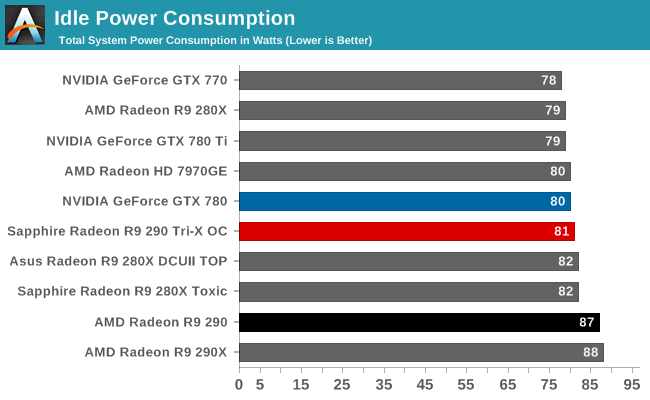
Curiously, the power consumption of the 290 Tri-X OC is notably lower than the reference 290. This isn’t a fluke in our results and we don’t have a solid explanation for this at this time, but for some reason we’re able to idle at a lower degree of power consumption with Sapphire’s card than we are our reference card. There is a difference in fans due to the different coolers, but based on what we’ve seen in the past we don’t believe the fans are responsible for this.
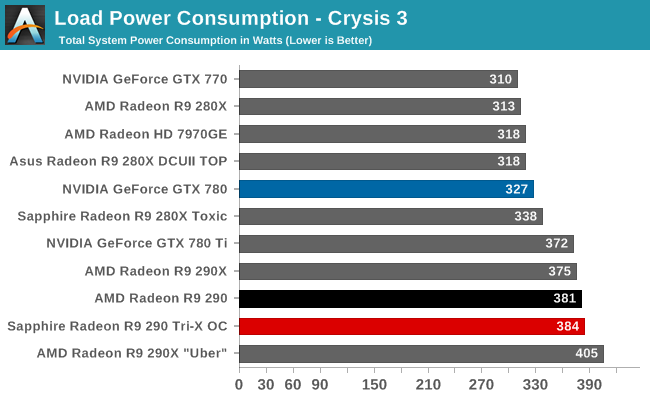
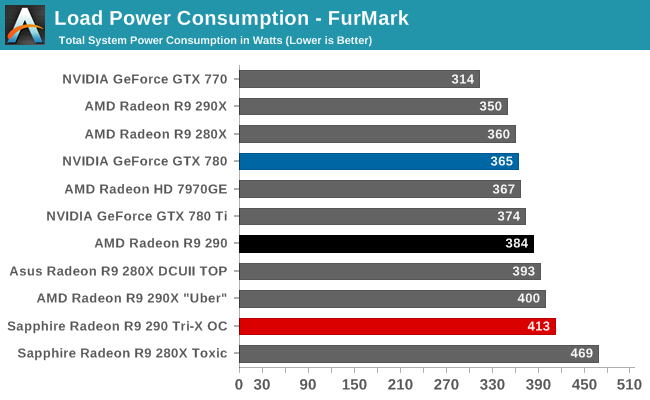
As for load power consumption, we have two different scenarios going on. Under our gaming workload the reference 290 was already able to hit its maximum boost clock, so with the 290 Tri-X OC operating at a similar voltage and only a slightly higher clockspeed, we’re not seeing a meaningful increase in power consumption. This being despite the lower temperatures of the GPU, which would normally offer at least some savings due to reduced leakage. What this means is that custom coolers will not be able to do anything about the 290’s lesser weakness, which is its power consumption relative to the GTX 780.
Meanwhile for FurMark, the reference 290 would throttle here based on both thermal and power limitations, whereas the Sapphire 290 is only limited by power. As a result it’s able to maintain higher clockspeeds and hence higher power consumption levels than the reference 290. Or in other words, the reference 290 was held back by its cooler here, while the 290 Tri-X OC is held back by its board power limits.
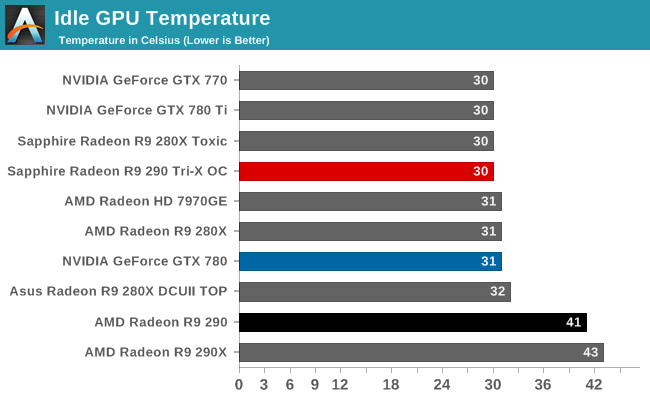
Moving on to idle temperatures, Sapphire’s 290 performs as we’d expect it to. AMD’s blowers were somewhat hobbled here, but with an open air cooler in the mix idle temperatures for just about every card is going to bottom out at around 30C.
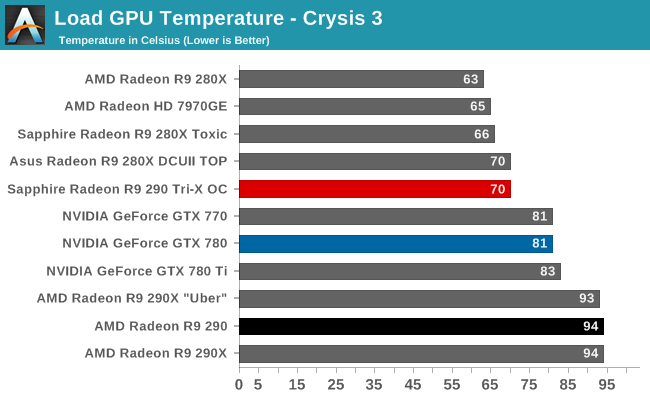
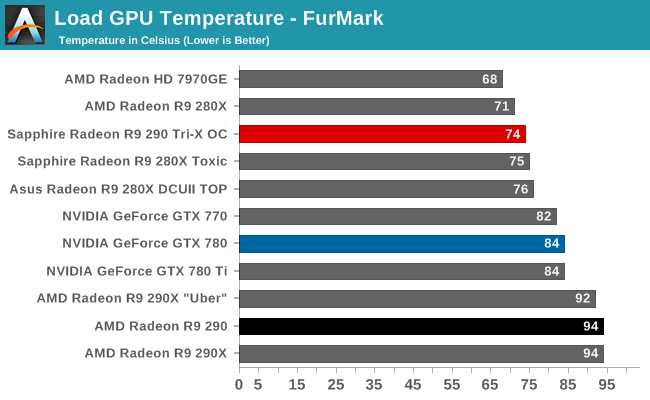
With our load temperatures we get our first sign of how well Sapphire’s Tri-X cooler can handle a Hawaii GPU, and so far things are looking good. Under Crysis 3 the Sapphire 290 is topping out at 70C, right in the range we’d expect an open air cooler. Meanwhile in our worst case scenario of FurMark the Sapphire card only warms up a few more degrees to 74C. Compared to AMD’s reference card this is of course a huge difference, representing a 24C and 20C improvement respectively. As we saw in our review of the 290X high temperatures aren’t necessarily a problem so long as they’ve been planned for in the design phase, but at the same time for the reference 290 series cards this went hand-in-hand with thermal throttling. Meanwhile Sapphire’s card will have no such problem, as it clearly has plenty of thermal headroom to work with.
Ultimately the fact that we’re in the 70s tells us that (by our metrics) Sapphire has done a good job balancing temperatures and noise on their fan curve. It means the Sapphire 290 doesn’t deliver the coolest temperatures, particularly under our gaming workloads, but it also means the cooler isn’t working harder than it really needs to (and generating more noise in the process). For a non-overclocking card there’s little benefit to having temperatures below 70C.
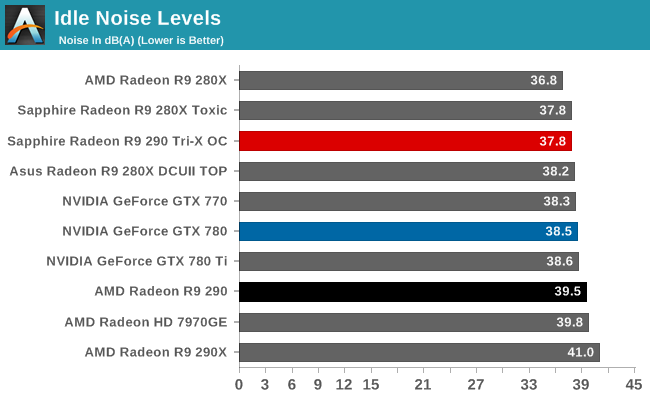
Last but not least is of course our section of noise benchmarks, starting with idle noise levels. Given the reference 290’s weaknesses and the 290 Tri-X OC’s strengths, Sapphire’s card is in a good position to resolve the 290’s biggest drawback, making our noise testing by far the most interesting aspect of this review in our eyes.
Anyhow, idle noise testing starts off well enough. At 37.8dB(A) the 290 Tri-X OC is near the top of our charts, tightly clustered among other open air coolers and tying the other Tri-X card in our roundup, the 280X Toxic.
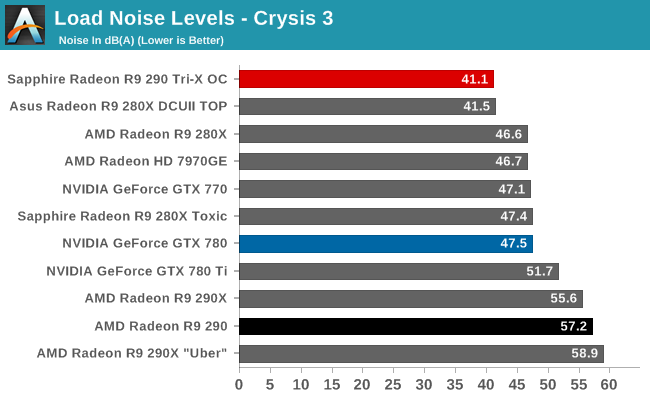
Over the last few months we’ve seen some very impressive open air cooled cards come across our labs. But as 2013 comes to a close it may very well be Sapphire’s 290 Tri-X OC that’s the most impressive of them all. Despite the high power load presented by a 290 card and in contrast to the problems AMD’s reference cooler encountered, Sapphire’s 290 Tri-X OC completely sweeps the field here. We would just as well have expected it to beat all of our blower based cards and even tie some of our other open air cooled cards, but as we can see it has gone above and beyond every other card when it comes to noise levels under our Crysis 3 gaming workload.
At 41.1dB the 290 Tri-X OC beats a number of Tahiti based cards, including our 7970GE and Sapphire’s own 280X Toxic, and it even edges out Asus’s impressive 280X DirectCU II. This not only makes Sapphire’s 290 the quietest high-end card we have, but it also means we’re seeing Sapphire dissipate an estimated 250W of heat while only generating a very, very limited amount of noise while doing so. Or to put this another way, Sapphire’s 290 is 16dB quieter than the reference 290, nullifying our earlier noise concerns and then-some.
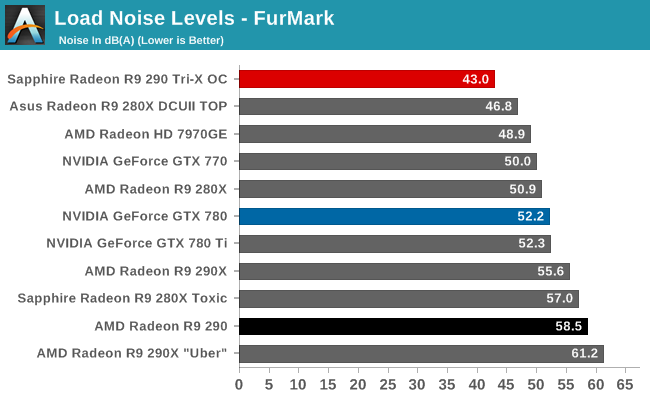
Under FurMark Sapphire’s extremely impressive cooling performance continues unabated. Even with the additional thermal load imposed by FurMark our noise levels only rise to 43dB, which by our standards would still be considered very quiet under even Crysis 3, never mind a pathological program like FurMark. With FurMark being the worst case scenario for a card’s cooler, this is clear evidence that the Tri-X cooler is capable of handling everything that Hawaii can throw at it, and that it can be handled with ease.
Ultimately at the risk of reducing an entire review down to a few numbers, these noise values are the metrics we came into this review interested in measuring, and to that end Sapphire has completely blown our expectations. Just being an “average” open air cooled card would have been a significant improvement over the reference 290, but to cool a 290 this well makes it a significant game changer.










119 Comments
View All Comments
Drumsticks - Wednesday, December 25, 2013 - link
More or less exactly! Anandtech can do what they want but I do kind of hate our silly system of measurement. It isn't going anywhere sadlymond0 - Wednesday, December 25, 2013 - link
From his tone, it's clear that he's not being defensive, but merely pointing out the reasons why AnandTech uses imperial measurements to a person who felt like it was Ryan's *duty* to spoon feed him metric measurements so he wouldn't have to do "calculations in the head" while the majority of the viewerbase would. Calling him "defensive" is the closest thing to "you mad bro" you can say.juhatus - Wednesday, December 25, 2013 - link
Sorry, I was not trying to be smart ass about this. I bet the split for readers is 50% US and 50% international. I really tried to be as neutral as I can and no I don't help calculating.Ryan any comment? Is there any policy about standards?
bigboxes - Thursday, December 26, 2013 - link
Sorry. It's not 50/50. I'm sure that it's >70%, but you've got me curious as to the real numbers. Almost everything on this site is for American buyers. You get the occasional "it's only available in Europe", but usually it's US-centric. So inches it is. You can get an android conversion app if you don't want to google it.bigboxes - Thursday, December 26, 2013 - link
HA! I was wrong. US only 33.6% of traffic. D'oh!ShieTar - Wednesday, December 25, 2013 - link
"the majority of the buyers of this level of video card are also in the U.S."I'm confused, how would you figure that? The European markets for consumer electronics have overtaken the North-American market in volume about a decade ago, and 2-3 years ago the combined volume of both have become smaller than the Asian market. Even with a relatively high-end card like this, I would be surprised if more than 25% of sales go to the U.S. these days.
Also, why would a majority of AT readers be American? Funny measurement units and the price comparisons aside, there is nothing on here that is specifically tailored to the US market. As the majority of tech-savy Europeans is rather fluid in English, I'm sure AT gets just as many European readers, keeping in mind the much larger overall population.
TheJian - Saturday, December 28, 2013 - link
I didn't realize Europe was a country...Silly me. This is a USA site, get over it. The site is based in NC, USA last I checked and am unaware of it having any server in another country. You're more than welcome to FUND the development of a FOREIGN soil based expansion.Does any single country buy more than your assumed 25% that goes to USA? Germany, Russia, France etc? You're counting europe as one entity and it's not. There is nothing wrong with catering to his OWN audience. If you want to read it from outside, fine. But don't expect anyone to alter their world to suit yours. It's just not this site's job. There are not many other web sites with multi language and I don't know of many USA sites using multi-language or even metric.
With US traffic being 33%, there is no other larger country coming to read this site correct? I translate chinese/german tech pages all the time. Sure I wish they'd put them up in English for me, but realize that it is cost prohibitive to do so. No point in asking as I'd rather have that cost go to reviewing more products etc. That's what translators are for anyway :)
ShieTar - Monday, December 30, 2013 - link
You seem to be a little confused about my statement. Try reading it again, and point out to me where I demanded that AT change anything? I merely pointed out some weak points in the comment of "wetwareinterface". I also did not pretend Europe was a country, merely an economic entity, which it is. I live in Europe, working for a European company, I can order products from any European shop without having to bother about any customs/tariff, I can move to and work in any other European Union country without any paperwork, etc. The different national governments at this point are merely another level of administration, but not something that seriously affects our everyday life.More importantly though, none of that matters to my original point, which was just to point out that an estimated 25% are a far way from "the majority", as the other 75% who come from "metric system nations" would be clearly the majority.
mpdugas - Thursday, December 26, 2013 - link
Since number systems are purely imaginary, what difference does how you measure an object make?Some folks find fractions easy, some like decimals better, but they are just fractions, too.
It really just comes down to which you prefer; the object does not change, no matter which fraction system you use.
xTRICKYxx - Tuesday, December 24, 2013 - link
Wow, that cooler is something else.